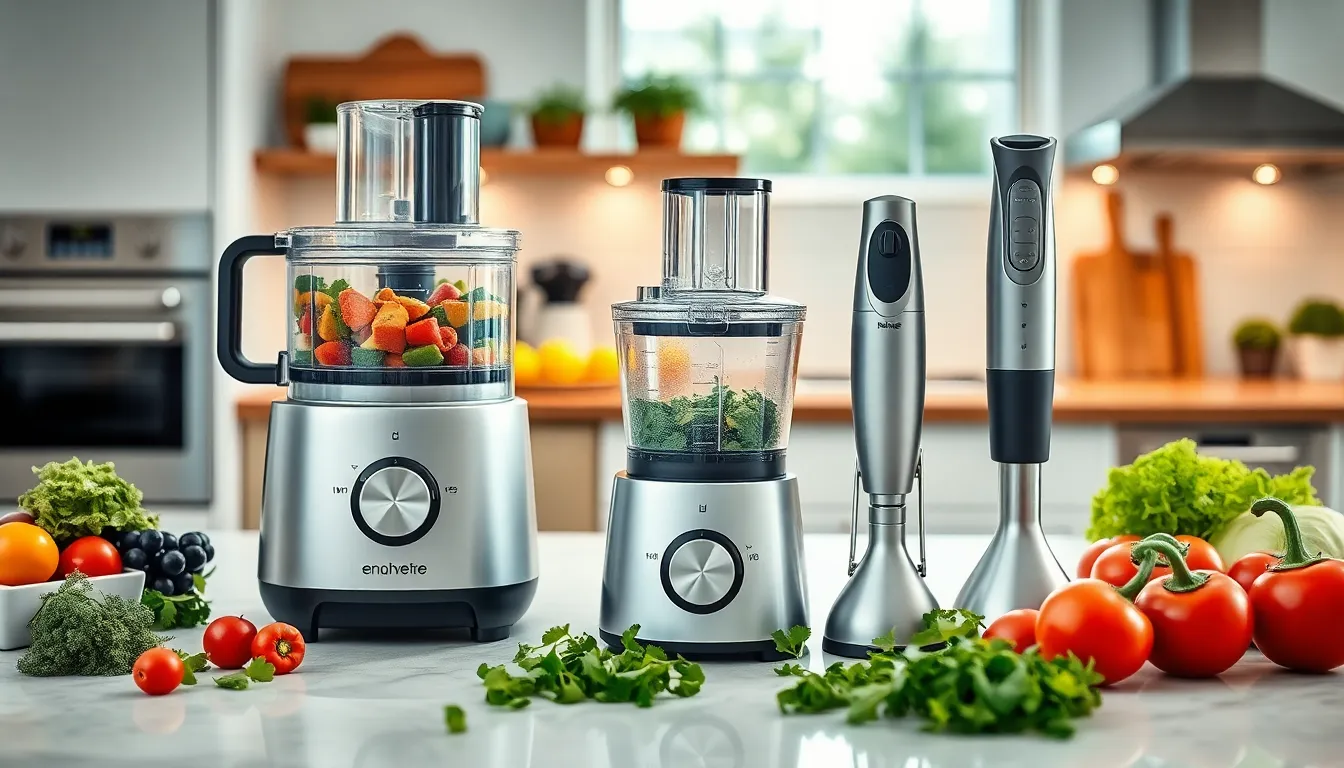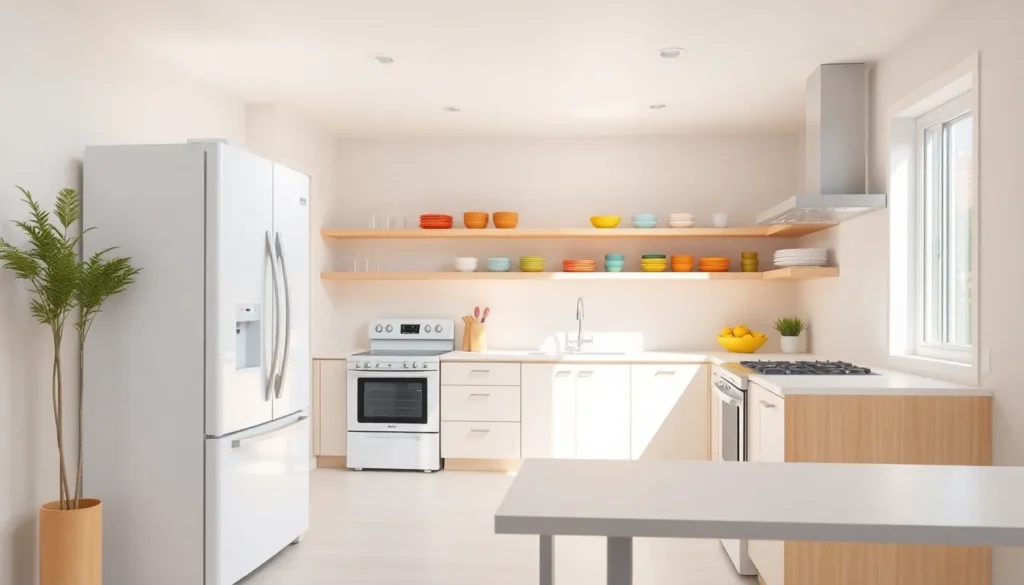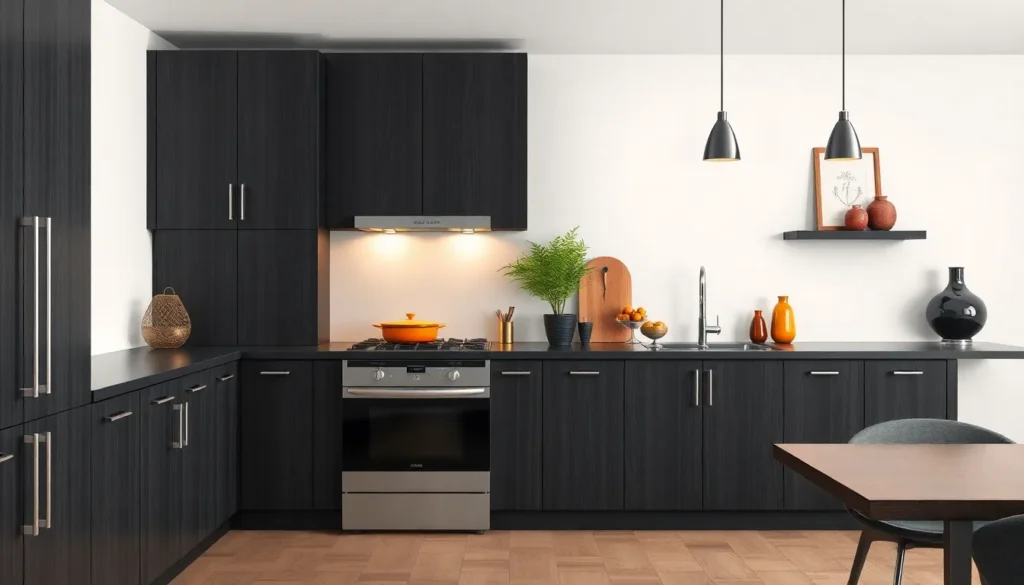In today’s fast-paced world, food processors have become essential kitchen companions. These versatile appliances simplify meal preparation, turning tedious tasks into quick and easy steps. Whether chopping vegetables, blending sauces, or kneading dough, food processors save time and effort, making cooking more enjoyable.
With a variety of models available, choosing the right food processor can feel overwhelming. From compact designs perfect for small kitchens to powerful machines capable of handling large batches, there’s an option for everyone. Understanding the features and benefits of each type can help home cooks elevate their culinary skills while streamlining their cooking process.
Table of Contents
ToggleOverview of Food Processors
Food processors are versatile kitchen appliances designed to assist in various food preparation tasks. They save time and effort by streamlining processes like chopping, slicing, and blending.
What Is a Food Processor?
A food processor is an electric appliance used for food preparation tasks including chopping vegetables, blending ingredients, and kneading dough. It features a motorized base, interchangeable bowls, and various attachments such as blades and discs. Common capacities range from 3 to 16 cups, allowing cooks to handle small or large quantities efficiently.
Benefits of Using Food Processors
Food processors offer several advantages for home cooks, including:
- Time-saving: Food processors significantly reduce meal prep time by performing multiple tasks quickly.
- Versatility: They handle a wide range of tasks from grating cheese to pureeing soups, making them adaptable for different recipes.
- Consistency: Food processors ensure uniform chopping and mixing, contributing to even cooking and professional-looking dishes.
- Ease of use: Simple controls and attachments make food processors accessible for users of all skill levels.
- Space-saving: Many models feature compact designs, making them easy to store in smaller kitchens.
Utilizing a food processor enhances the cooking experience, enabling efficient preparation and creative culinary possibilities.
Types of Food Processors

Different types of food processors cater to various culinary needs, each with unique features that enhance food preparation.
Full-Size Food Processors
Full-size food processors typically feature a capacity ranging from 8 to 16 cups. These appliances excel at handling larger quantities of ingredients, making them ideal for meal prep for families or entertaining. Equipped with powerful motors, they can chop, slice, shred, and knead dough efficiently. Many models include various attachments, such as slicing discs or dough blades, expanding their versatility. Popular options include brands like Cuisinart and KitchenAid, which often offer additional features like multiple speed settings for precise control.
Mini Food Processors
Mini food processors provide a compact solution for smaller tasks. With capacities of 3 to 5 cups, these processors excel at chopping herbs, nuts, and small quantities of vegetables. Their size makes them easier to store and convenient for quick jobs. Despite their smaller size, many models still offer multiple functions, including pureeing and emulsifying. Brands like Hamilton Beach and Breville manufacture a range of mini food processors that emphasize portability and efficiency.
Immersion Blenders
Immersion blenders, also known as hand blenders or stick blenders, differ structurally from traditional food processors. They consist of a blending shaft with blades attached to a handheld motor, ideal for pureeing soups directly in pots or blending smoothies. Immersion blenders are lightweight and easy to clean, often requiring minimal storage space. Popular brands include Breville and Cuisinart, which provide various attachments for enhanced functionality, such as whisking and chopping.
Each type of food processor serves specific culinary functions, allowing cooks to choose the most suitable appliance based on their cooking habits and requirements.
Key Features to Consider
Choosing the right food processor involves understanding several key features that influence performance and usability. Attention to motor power, bowl capacity, and blade types can enhance cooking efficiency and versatility.
Motor Power
Motor power significantly affects a food processor’s performance. Units generally range from 300 to 1200 watts. Higher wattage provides better efficiency in handling tough ingredients, such as hard vegetables or doughs. For home cooks planning to process heavy mixtures or use the food processor frequently, a motor with at least 600 watts is advisable.
Bowl Capacity
Bowl capacity determines how much food the processor can handle at once. Capacities typically range from 3 to 16 cups. For small kitchens and occasional usage, a 3 to 5 cup bowl suffices. For meal prep for larger families or batch cooking, an 8 to 16 cup bowl is preferable. Selecting the right size helps streamline food preparation and minimizes the need for multiple processing rounds.
Blade Types and Functions
Blade types and functions play a critical role in determining a food processor’s versatility. Standard components include:
- Multipurpose blades: Ideal for chopping, blending, and mixing.
- Slicing discs: Used for uniform slicing of fruits and vegetables.
- Shredding discs: Designed for grating cheese and vegetables.
- Dough blades: Tailored for kneading doughs and heavy mixtures.
Assessing the available blades ensures that the food processor meets specific culinary tasks efficiently.
Top Food Processor Brands
Several brands dominate the food processor market, known for their reliability, performance, and innovation in kitchen technology. Here are three top brands recognized for their quality offerings.
Brand A
Brand A stands out for its powerful motors and advanced features, making it suitable for both home cooks and culinary enthusiasts. With motor power ranging from 600 to 1200 watts, these food processors handle tough ingredients efficiently. Their full-size models boast options like multiple bowl sizes and various blade attachments, enhancing versatility. Customer reviews often highlight the user-friendly interface and easy cleanup, solidifying Brand A’s reputation as a reliable choice.
Brand B
Brand B specializes in compact and efficient food processors, catering to smaller kitchens or those needing quick meal prep solutions. Models typically range from 3 to 8 cups, perfect for chopping, slicing, and pureeing. Known for their durable construction, Brand B’s products often feature storage solutions for attachments, minimizing clutter. Users appreciate the straightforward design and consistent performance, reinforcing Brand B’s status as an excellent choice for everyday tasks.
Brand C
Brand C is synonymous with innovation, offering food processors equipped with unique features like touchpad controls and programmable settings. These models, ranging from 8 to 16 cups, provide flexibility for larger preparations. Their focus on safety includes features such as locking mechanisms and non-slip bases. Consumers commend Brand C for quality performance, making it an ideal option for those who frequently prepare diverse dishes.
Food processors are essential tools that transform meal preparation into a more enjoyable and efficient process. With a variety of models available, home cooks can find the perfect fit for their culinary needs. The right food processor not only saves time but also enhances creativity in the kitchen.
Understanding the key features and benefits of each type ensures that cooks can make informed choices. From full-size models for family meals to compact versions for quick tasks, there’s a food processor tailored for every kitchen. Investing in a quality food processor can significantly elevate the cooking experience, making it easier to explore new recipes and techniques.









